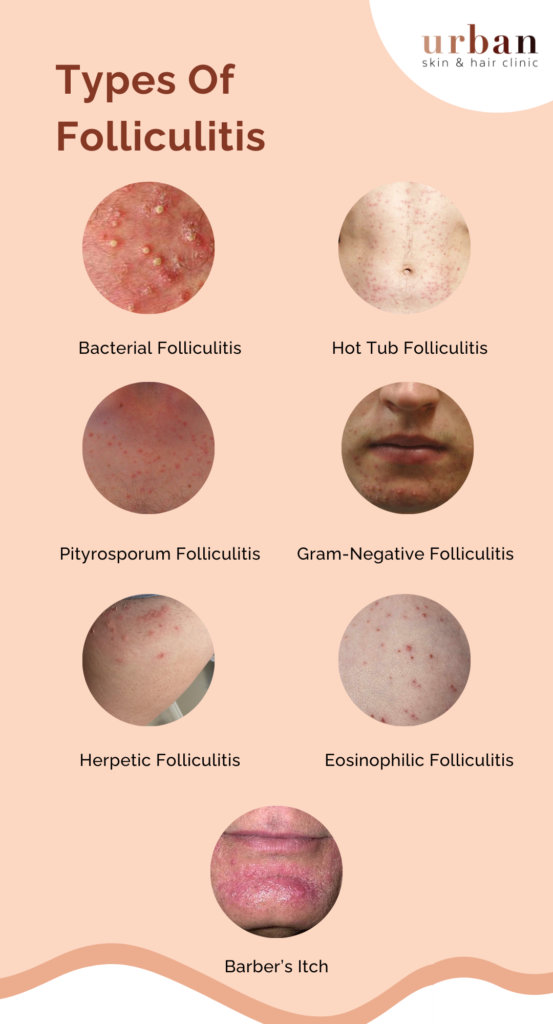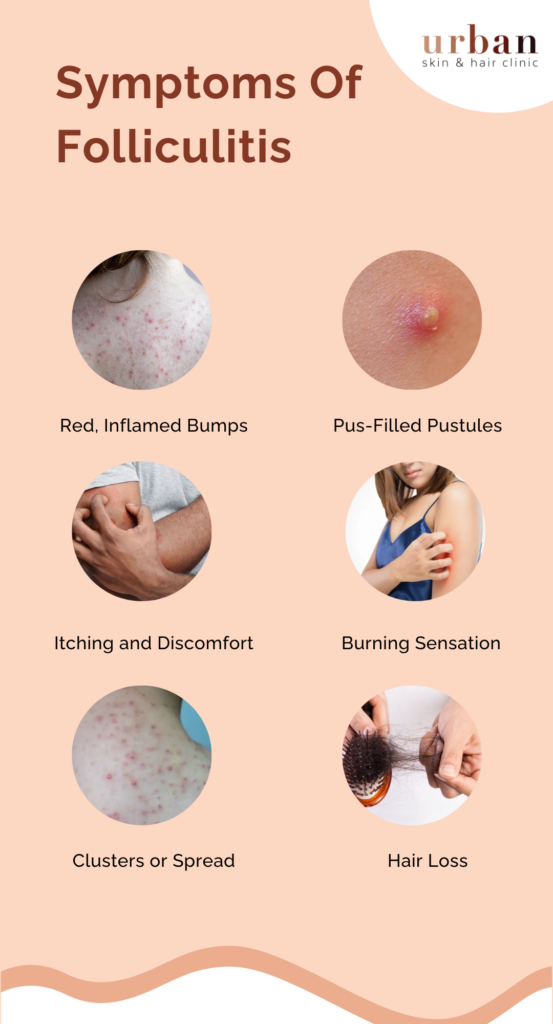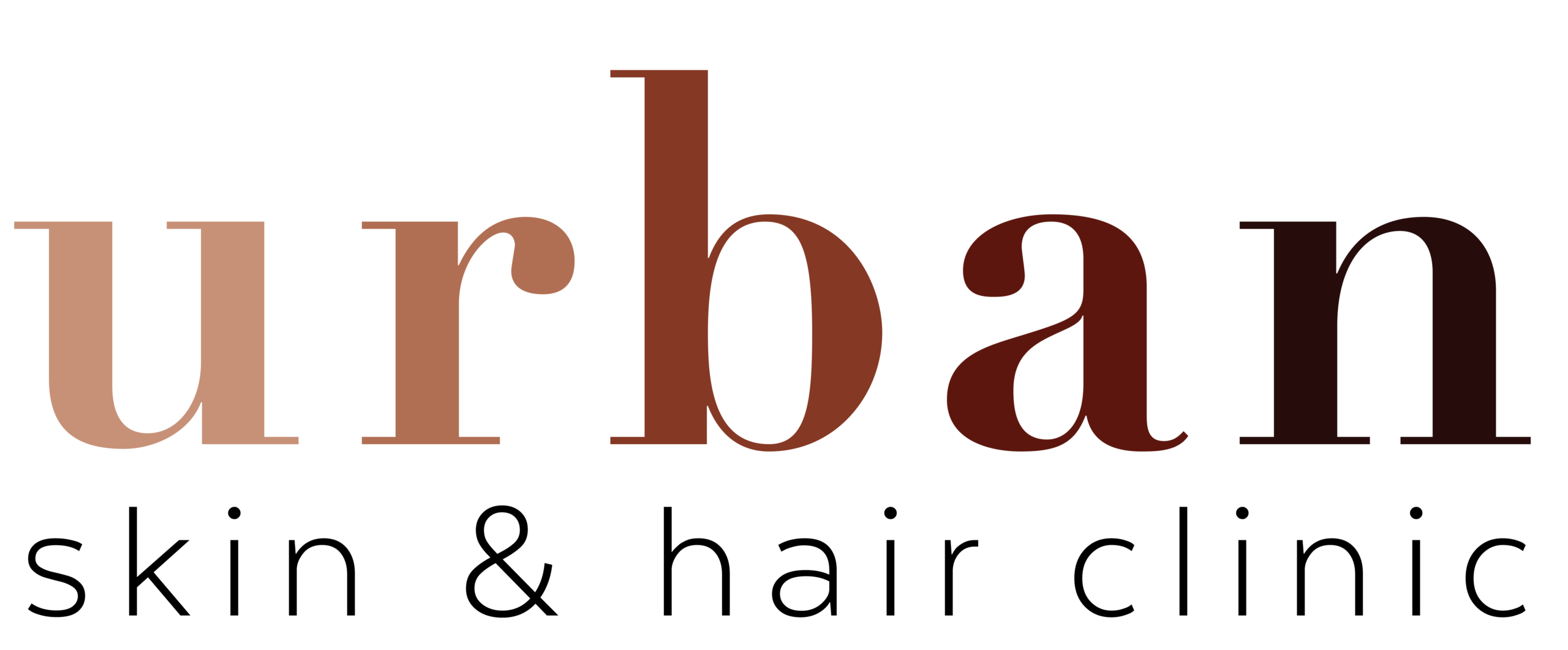
What is Folliculitis?
Folliculitis is a common skin condition characterized by the inflammation and infection of hair follicles. It occurs when bacteria, fungi, or viruses enter the hair follicles, leading to red, swollen, and pus-filled bumps on the skin. Folliculitis can affect various areas of the body where hair is present, such as the scalp, face, neck, chest, back, arms, and legs.
The condition can be itchy and uncomfortable, and seeking professional evaluation and treatment at Urban Skin & Hair Clinic is essential for proper diagnosis and management.
What are the Types of Folliculitis?
Folliculitis can manifest in different forms, with each type characterized by its underlying cause and specific characteristics. Here are the common types of folliculitis:
- Bacterial Folliculitis: Bacterial folliculitis is the most common type of folliculitis and is caused by the invasion of hair follicles by bacteria, such as Staphylococcus aureus. Bacterial folliculitis can occur on any part of the body with hair, especially in areas prone to friction or sweating.
- Hot Tub Folliculitis: Hot tub folliculitis, also known as Pseudomonas folliculitis, develops after exposure to contaminated hot tubs or swimming pools. It is caused by the Pseudomonas aeruginosa bacterium.
- Pityrosporum Folliculitis: Pityrosporum folliculitis is caused by the overgrowth of yeast (Malassezia) in hair follicles. It is commonly observed in areas with a high density of sebaceous glands, such as the upper chest, back, and shoulders.
- Gram-Negative Folliculitis: Gram-negative folliculitis is a rare complication of long-term antibiotic treatment for acne. It occurs when certain bacteria, such as Escherichia coli or Klebsiella, become resistant to treatment and cause a more severe form of folliculitis.
- Herpetic Folliculitis: Herpetic folliculitis is caused by the herpes simplex virus (HSV). It results in painful, fluid-filled blisters that may occur in clusters around hair follicles. The infection is highly contagious and can be spread through direct contact.
- Eosinophilic Folliculitis: Eosinophilic folliculitis is a rare type of folliculitis that is more commonly observed in individuals with weakened immune systems, such as those with HIV/AIDS.
- Barber’s Itch: Barber’s itch, also known as tinea barbae, is a type of fungal folliculitis caused by the Trichophyton or Microsporum fungi. It typically affects the beard area and is commonly seen in men who shave.

What are the Causes of scabies?
Fungal infections are caused by various types of fungi that thrive in specific environmental conditions, leading to their proliferation on the skin and other body areas. Understanding the underlying causes of these infections can help individuals take preventive measures and seek appropriate treatment at Urban Skin & Hair Clinic. Here are the primary causes of fungal infections:
Signs & Symptoms of Folliculitis
Folliculitis presents with a distinct set of signs and symptoms, and recognizing these manifestations is crucial for seeking timely and appropriate treatment at Urban Skin & Hair Clinic. The symptoms may vary depending on the type and severity of the condition. Here are the common signs and symptoms of folliculitis:
- Red, Inflamed Bumps: The primary characteristic of folliculitis is the appearance of red, inflamed bumps on the skin. These bumps are usually small and may be slightly raised. They can occur around hair follicles and may be itchy or tender to the touch.
- Pus-Filled Pustules: In some cases, the inflamed bumps may develop into pustules, which are small, white or yellowish bumps filled with pus. These pustules may be more noticeable when the folliculitis is bacterial in nature.
- Itching and Discomfort: Folliculitis can cause varying degrees of itching, which can be mild to severe. The affected area may feel uncomfortable and irritated, leading to a desire to scratch.
- Burning Sensation: Some individuals with folliculitis may experience a burning sensation in the affected area, especially when the inflammation is more pronounced.
- Clusters or Spread: Folliculitis bumps may occur individually or in clusters, particularly in areas with hair, such as the scalp, face, neck, chest, back, arms, and legs. The condition may spread to adjacent follicles or other areas with repeated irritation or scratching.
- Crust Formation: In bacterial folliculitis, the pustules may rupture and crust over. This can be a sign of the body’s response to the infection.
- Hair Loss (in severe cases): Severe or recurrent cases of folliculitis may lead to temporary hair loss in the affected areas.
- Systemic Symptoms (rarely): In some instances, folliculitis may cause systemic symptoms, such as fever, chills, or general malaise. This is more common in cases of extensive or deep-seated bacterial infections.

Treatment for Folliculitis
The treatment for folliculitis depends on the type and severity of the infection. Seeking professional medical evaluation at Urban Skin & Hair Clinic is crucial to determine the specific cause of folliculitis and to receive personalized treatment. Here are the common approaches to treating folliculitis:
For mild cases of folliculitis, applying warm compresses to the affected area can help reduce inflammation and promote drainage of any pus-filled bumps. This can be done several times a day to alleviate discomfort.
Topical antiseptics, such as hydrogen peroxide or benzalkonium chloride, can be used to cleanse the affected area and help prevent bacterial infection. They may be particularly helpful for mild cases of bacterial folliculitis.
In cases of bacterial folliculitis, topical antibiotics, such as mupirocin or neomycin, may be prescribed to directly target the infection and reduce inflammation. These antibiotics can help control bacterial growth and prevent the condition from worsening.
For more severe or extensive bacterial folliculitis, oral antibiotics may be necessary. The healthcare provider may prescribe antibiotics such as cephalexin, dicloxacillin, or clindamycin, depending on the type of bacteria causing the infection.
If folliculitis is caused by a fungal infection, topical or oral antifungal medications, such as clotrimazole or fluconazole, may be prescribed to combat the fungal overgrowth.
For folliculitis caused by a viral infection, such as herpetic folliculitis, antiviral medications like acyclovir or valacyclovir may be prescribed to control the viral activity.
By following the prescribed treatment plan and taking preventive measures, individuals can effectively manage and overcome folliculitis, promoting healthier and more comfortable skin. Early intervention with appropriate treatment can lead to faster recovery and prevent complications associated with severe or recurrent cases of folliculitis.


